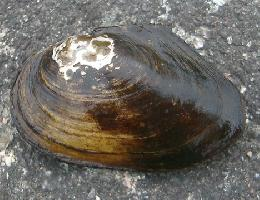
Descrierea animalului
The Swan Mussel, scientifically known as Anodonta cygnea, is a captivating species of freshwater bivalve belonging to the family Unionidae. This species is distinguished by its large, elegant shells and its significant role in the ecosystems of ponds, lakes, and slow-moving rivers across Europe and parts of Asia. The name "Swan Mussel" is derived from its graceful appearance and large size, reminiscent of a swan, one of nature's most elegant birds.Physical Characteristics:
Swan Mussels possess an impressive shell that can grow up to 15 centimeters in length, although some specimens may reach up to 20 centimeters, making them one of the largest freshwater mussels in their native habitat. The shell is oval or elliptical in shape, with a smooth and shiny outer surface that ranges in color from dark brown to greenish or bluish-black. The inner surface of the shell, or nacre, is usually pearly white, adding to the mussel's aesthetic appeal.
The soft body inside the shell is equally fascinating. The Swan Mussel has a large muscular foot, which it uses to move through the substrate and anchor itself in place. It also possesses gills that serve both for respiration and as a means of filtering food from the water. This species is a filter feeder, relying on a diet of plankton, detritus, and microscopic organisms, which it sieves from the water using its gills.
Habitat and Distribution:
Swan Mussels are found in a variety of freshwater habitats, including ponds, lakes, canals, and slow-flowing rivers. They prefer clear, calm waters with sandy or muddy bottoms where they can bury themselves. Their distribution covers much of Europe and extends into parts of Asia, although their numbers have been declining in some areas due to habitat loss, pollution, and other environmental pressures.
Reproduction and Lifecycle:
The reproduction process of Swan Mussels is intriguing. They are dioecious, meaning that individuals are either male or female. During the breeding season, males release sperm into the water, which is then drawn in by the females through their siphons. The females fertilize their eggs internally and develop larvae known as glochidia within their gills.
Once the glochidia are mature, they are released into the water, where they must attach to the gills or fins of a suitable fish host to continue their development. This parasitic stage is crucial for the larvae's growth and survival. After several weeks, the glochidia transform into juvenile mussels and detach from the host, settling into the substrate to begin their benthic life.
Ecological Role and Conservation:
Swan Mussels play a vital role in their ecosystems. As filter feeders, they help maintain water clarity and quality by removing particles and pollutants. They also serve as a food source for various animals, including fish, otters, and some birds.
However, Swan Mussels face threats from habitat destruction, water pollution, and the introduction of invasive species. Conservation efforts are crucial to protect these mussels and their habitats. Measures include improving water quality, protecting natural habitats, and raising awareness about the importance of freshwater mussels in ecosystems.
In summary, the Swan Mussel is a remarkable freshwater bivalve with a striking appearance, interesting biology, and significant ecological value. Despite facing challenges, it continues to thrive in certain areas, symbolizing the beauty and resilience of freshwater ecosystems.
Animale similare
Fotografii noi cu animale
Top 10 animale
- Dolphin gull (Leucophaeus scoresbii)
- Diana monkey (Cercopithecus diana)
- Moustached guenon (Cercopithecus cephus)
- Stone loach (Barbatula barbatula)
- Greek tortoise (Testudo graeca)
- Galápagos tortoise (Geochelone nigra complex)
- Japanese macaque (Macaca fuscata)
- Russian tortoise (Testudo horsfieldii)
- Common flying dragon (Draco volans)
- Galápagos penguin (Spheniscus mendiculus)


